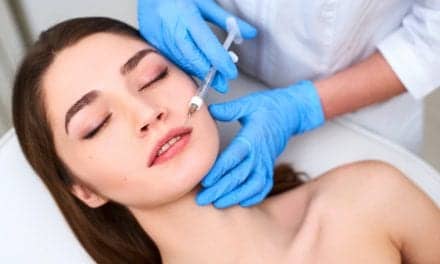The American Academy of Facial Plastic and Reconstructive Surgery (AAFPRS) announces the outcomes of its annual survey, which explores the top trends in facial plastic surgery over the past year and shares predictions for what’s to come.
Topping the trends, according to the survey, are combination therapies, with 66% of facial plastic surgeons reporting that combining nonsurgical procedures in the same patient is the most popular in their practices.
Multitasking & Maintenance
“It’s an exciting time for facial plastic surgery, with more and more noninvasive therapies becoming available to us,” says Dr Fred G. Fedok, president of the AAFPRS, in a media release. “By combining injectables, lasers, ultrasound and radiofrequency, we are able to offer highly individualized therapies to a much wider range of patients. We can also use these non-invasive options to enhance surgical results and speed recovery time for optimal outcomes.”
Whether its fillers plus neurotoxins to smooth wrinkles or energy-based treatments to lift sagging skin, patients today are all about multitasking and maintenance to slow down the hands of time. “Patients want to look good for their age for as long as possible, and we now have the tools to provide visible lasting results with and without surgery,” Fedok adds.
The Power of Prejuvenation
The number of patients under 30 seeking cosmetic tweaks continues to grow. Fifty one percent of AAFPRS members agree that more patients now emphasize early maintenance, with increasing numbers of men and women in their 20s and 30s opting for preventative measures to forestall bigger procedures and surgery. This emerging segment uses advanced skincare, practices sun prevention, and starts with facial injectables before they turn the big 3-0. In fact, more than half (56%) of facial plastic surgeons saw an increase in 2016 in cosmetic surgery or injectables with patients under age 30.
“The focus has shifted from correction to prevention. Even before the first signs of sagging, lines or volume loss, we are seeing patients adamant about stalling the aging process,” Fedok adds, in the release.
Nearly all AAFPRS members (99%) agree that celebrity influence still plays a big role. Consumers are constantly bombarded with images of ageless stars, and want access to that fountain of youth.
Chemical Peels Rise Again
Dating back to the Egyptians, chemical peels have long been a favorite for revitalizing skin. With a wide range of combinations of acids and enzymes in various concentrations from mild and moderate to deep, facial plastic surgeons can treat sun damage, brown spots, wrinkles, acne and improve lackluster skin tone and texture with peels.
Gone are the days of the red, blistering post-peel skin and days of hiding away due to more advanced and buffered solutions, Consumers are responding to these new formulations. The survey showed that chemical peels are in strong demand with over half (52%) of AAFPRS members last year.
Fedok warns in the release that, “While it may be tempting to order your own high concentration solutions on the Internet, consumers should stick to a concentration of 10% or less for peels with alpha hydroxy acids or AHAs, like salicylic and glycolic acids. Always consult with your skin care professional before trying aggressive peels on your own to avoid any possible adverse events and achieve the desired result.”
Social Media and Plastic Surgery
According to AAFPRS members, two of the top drivers for cosmetic procedures are the desire to remain competitive in the workforce and the impact of social media.
Forty-nine percent of surgeons reported patients’ wanting to stay relevant and vital at work, while social media remains a huge incentive to have some work done with even more surgeons (42%) than last year reporting patients seeking cosmetic procedures to look better in selfies, Instagram, Snapchat, Facebook Live, and other social channels.
The most requested procedures were tailored to these specific lifestyle concerns. Eyelid procedures to look less tired were reported as a rising trend by 62% of members, as well as patients seeking cosmetic procedures due to dissatisfaction with their profile (49%) and patients requesting to “get their cheekbones back” (46%).
Botox (Allergan), along with Dysport (Galderma) and Xeomin (Merz), remain the most popular minimally invasive procedure for both women and men, followed by hyaluronic acid fillers. As for surgical trends, rhinoplasty (nose surgery) leads the way again, followed by revision surgery, blepharoplasty (eyelid surgery), and facelifts.
What’s Next
“Look out for new hyaluronic acid fillers coming soon to the United States,” Fedok states. “In the meantime, recently approved Volbella for lips and Restylane Refyne and Defyne for marionette lines and deep set wrinkles will be big this year. We also predict more novel uses for botulinum toxins and super-powered topical agents that may reduce unwanted under-eye fat and smile lines.” More men are getting in on the action too, in particular with Botox and chin fat reduction treatments.
For those ready for surgical solutions, a natural-looking result is paramount. Sixty-five percent of AAFPRS surgeons reported patients asking to avoid the telltale signs of surgery including a too short tip or scooped bridge when it comes to rhinoplasty. Many members also indicated that more patients are going online and bringing in images of natural noses for guidance, the release continues.
[Source(s): AAFPRS, PR Newswire]



